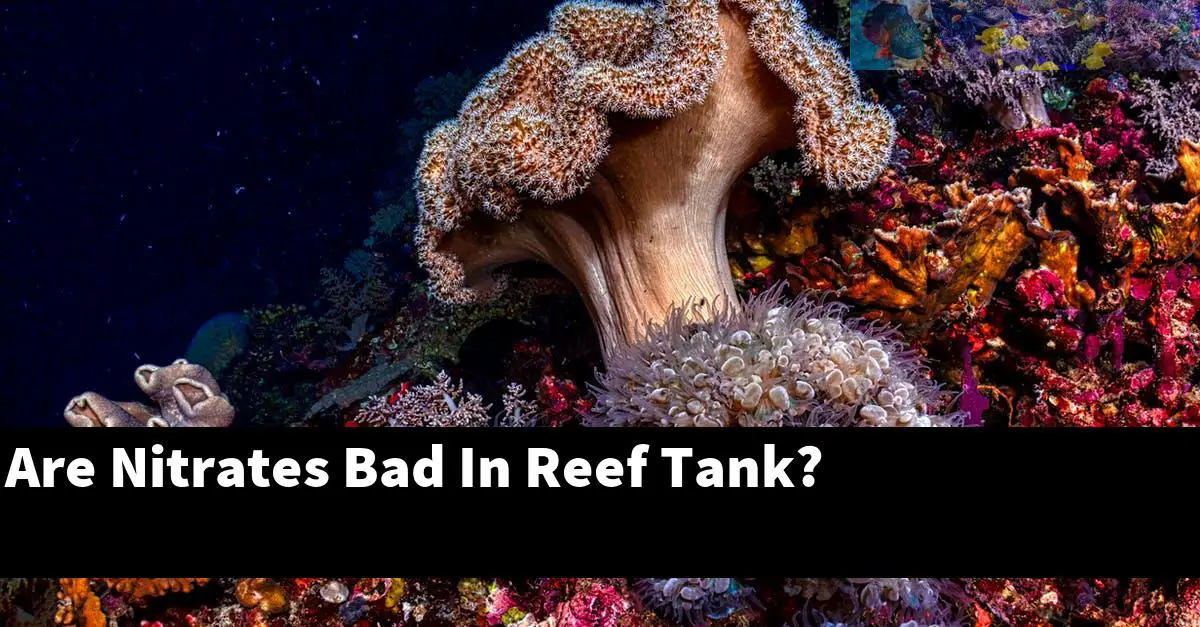Nitrates are generally considered to be bad in reef tanks because they can contribute to the growth of algae. However, some reef tanks actually rely on nitrates to help maintain a healthy balance. In these cases, it is important to monitor nitrate levels closely and make sure they do not get too high.
What are nitrates and why are they present in reef tanks?
Nitrates are a type of nitrogenous compound that are present in reef tanks as a byproduct of the photosynthesis process. They are used by marine invertebrates as a source of nitrogen and are also an important ingredient in the diet of some fish.
Nitrates can be harmful to marine organisms if they are over-consumed, so it is important to keep them in check in reef tanks.
How do nitrates affect coral growth and health?
Nitrates are an important nutrient for coral, as they can help the coral grow and thrive. However, too much nitrates can also be harmful to coral, as it can cause the coral to experience problems such as bleaching and coral death.
Instant Ocean Reef Crystals Reef Salt, Formulated Specifically For Reef Fish Tank Aquariums
$66.79 (as of June 14, 2025 00:55 GMT +03:00 - More infoProduct prices and availability are accurate as of the date/time indicated and are subject to change. Any price and availability information displayed on [relevant Amazon Site(s), as applicable] at the time of purchase will apply to the purchase of this product.)ReefHD Reef Flux Anti-Fungal Treatment (100 gal)
Red Sea ReefDose 4 Head Wireless Dosing Pump for Supplements, Foods & Trace Elements in Saltwater Aquariums | ReefBeat App Controlled Reef Marine
$459.00 (as of June 14, 2025 00:55 GMT +03:00 - More infoProduct prices and availability are accurate as of the date/time indicated and are subject to change. Any price and availability information displayed on [relevant Amazon Site(s), as applicable] at the time of purchase will apply to the purchase of this product.)When nitrates are present at high levels, the coral can’t properly absorb them and they can end up accumulating in the coral tissue. This can lead to the coral becoming white and brittle, and eventually dying.
What are the consequences of having too much or too little nitrates in a reef tank?
There are many potential consequences of having too much or too little nitrates in a reef tank. Too much nitrates can cause an increase in algae growth, while too little nitrates can lead to a lack of coral growth and a decrease in fish populations.
Too much nitrates can also cause fish to become sick and die, while too little nitrates can lead to a decrease in coral growth and an increase in algae growth. It is important to monitor nitrate levels in a reef tank to ensure that they remain at a healthy level.
How can nitrate levels be controlled in a reef tank?
Nitrate levels can be controlled in a reef tank by using a balanced marine aquarium diet, controlling water temperatures, and adding nitrate reducers. A balanced marine aquarium diet includes a high level of protein and low levels of carbohydrates and fats.
Water temperatures should be kept at a consistent 72 degrees Fahrenheit to help control nitrate levels. Nitrate reducers can be added to the tank to help control nitrate levels.
Are there any methods to remove nitrates from a reef tank?
Nitrates are a common contaminant in reef tanks and can be removed by a variety of methods. Chemical nitrate removers are the most common and effective approach but can be expensive and require regular use.
Other approaches, such as using an ozone generator or using nitrate-reducing bacteria, are less common but may be more effective in specific cases. It is important to note that nitrate removal will not fix a tank that is already over-stocked with this pollutant, and regular monitoring is essential to ensuring the tank remains healthy.
What is the ideal range of nitrates for a healthy reef tank?
The ideal nitrate range for a healthy reef tank is 0.25-5 ppm. This range allows for a healthy balance between nitrates and phosphate, while still providing enough nitrates to promote coral growth.
Too much nitrate can lead to algae growth and a decrease in coral health, while too little nitrate can result in a lack of color in coral colonies and an inability to form new coral tissue. A common nitrate test kit is available at most pet stores and can be used to monitor nitrate levels in your tank.
Is it ever necessary to add nitrates to a reef tank?
Nitrates are a common by-product of the nitrogen cycle in reef tanks. Nitrates can be harmful to fish and corals if they build up at high levels.
It is important to keep nitrate levels in reef tanks low by monitoring water parameters and adding nitrate-free plants and coral invertebrates to the tank.
Summary
Nitrates are a type of nitrogen that can be harmful to coral and other marine life in reef tanks. However, some reef tanks use nitrates in order to keep the tank’s ecosystem healthy.
If the levels of nitrates in a tank become too high, then it is important to take action to lower them.















